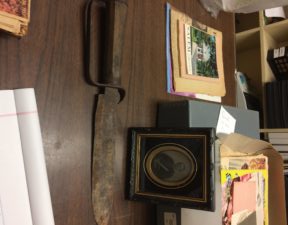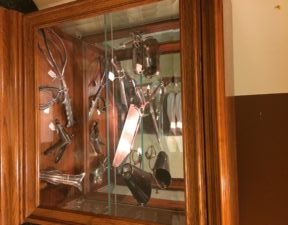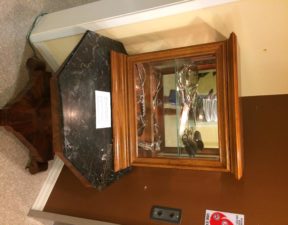


 In the many weeks that I have regrettably and unintentionally neglected this blog, much has been going on at the Salem Museum. The last time I updated the blog, I had started learning how to fill out accession forms for donated objects so that they can be logged into our online database and find a home in our archive. My supervisor, Alex Burke, tasked me with filling out accession forms for a donation of a handful of objects and, once that was completed, to go through and take some brief notes on another pile of donated objects to help determine what the museum may want to keep. Well, as it turns out, that task did not get completed until today, nearly three weeks later. My supervisor, the assistant director, went on vacation for a week, during which the head director, Frances Ferguson, had me begin on my first major project.
In the many weeks that I have regrettably and unintentionally neglected this blog, much has been going on at the Salem Museum. The last time I updated the blog, I had started learning how to fill out accession forms for donated objects so that they can be logged into our online database and find a home in our archive. My supervisor, Alex Burke, tasked me with filling out accession forms for a donation of a handful of objects and, once that was completed, to go through and take some brief notes on another pile of donated objects to help determine what the museum may want to keep. Well, as it turns out, that task did not get completed until today, nearly three weeks later. My supervisor, the assistant director, went on vacation for a week, during which the head director, Frances Ferguson, had me begin on my first major project.
I came in one day a few weeks ago while Alex was on vacation, and after some small talk, Fran told me of an idea she had had. The main entrance to the museum is a short hallway which opens up to the foyer, which includes the reception desk and the gift shop. On the left side of the hallway stands a table with some pamphlets and flyers. On the right sits an old bench that is technically a part of the collection, but we still put it to good use. Also, hanging on the wall are three paintings. I’ve walked through that hallway countless times by now, but I cannot begin to describe those paintings because I don’t think I’ve actually paid enough attention to them to notice. Fran recognizes that this is the experience of most of the visitors to the museum, so she wanted to make better use of the space. Her idea is to create a general timeline of Salem’s past to provide a context to the information that the museum expresses. This is a great idea, not only because it would be a better use of the space, but also because there really isn’t anywhere in the museum that gives background information of Salem; each exhibit dives into a specific aspect of Salem’s past, but nowhere do you quite get the full story. Once we had agreed that it was a great idea, (not that it truly mattered what I thought, she is the director after all), I began immediately doing research. My main source was a comprehensive history of Salem written by two former directors, John Long and Mary Crocket-Hill, (Long also used to be a professor of military history at Roanoke College), which the museum sells at its gift shop. I skimmed through all 200 some pages, picking out dates of importance. While there was some discretion on my part, I tried to include as much information as possible so that Fran and Alex could make the definitive decisions. Essentially, the entire week that Alex was gone consisted of me compiling that data, and then trying to put that data in chronological order. During this time I had the idea to include population numbers throughout the years to see Salem’s demographic growth as well. After about a week, I had everything compiled and put in chronological order and was ready to present my research to them; however that did not come to fruition. One Saturday I was sitting at the reception desk while helping out with an event the museum puts on called “Civil War Saturdays.” I was working on the final touches of my research notes for the timeline when I happened to glance down and see a binder labelled “Timeline of Salem.” I picked it up and started to leaf through it, and to my dismay I immediately found information that was not in my notes. It took me another few days, but I finally gathered everything I could find into one document and presented it to my superiors. I’m not sure when this timeline will be finalized and brought into existence, but I’m glad to have been a part of the project!
As one would expect, I learned quite a lot while working on the timeline. Even as someone who has lived in Roanoke and had relatives in Salem for my entire life, I quickly realized that I knew almost nothing about the area’s past. Salem has a very rich history, going back all the way to its founding in 1802! One day in the past weeks I was on a run around Salem for Cross Country summer training. As I was running, I was passing some of the very places that I had learned about in my research. For example, Lake Spring Park, better known as “The Duck Pond,” is named so because in the late 1800s, a hotel resort by the same name stood in the same spot. A fire caused it to close down, and a little later the property was bought by the city and turned into Salem’s first public park, which it remains to this day. I ran past the duck pond that day, reflecting on my experiences there; my parents had taken me there countless times as a kid. While the park had been a part of my own past, I did not know about its past until very recently. This made me think of all of the other places I had learned about, like the history of our own Elizabeth campus, and how there must be many more people like me who have lived here for many years but did not know about our area’s past. This led to an idea: what if the Salem Museum partnered with the City of Salem to erect signs at some of these places with a brief description of their respective histories? I pitched the idea to Fran, and then to Alex when he returned from the beach, and both really enjoy it! The museum does have a lot of things going on at the moment, so I don’t know when or even if my idea will progress into a reality, but I am working on researching and gathering resources for it!
The time that I’ve spent at the museum since my last post has been a whirlwind. I have been assigned and complete my first major project. I have learned every step of the process of bringing in new objects to the museum’s collection, from the initial donation to preserving it in the archive, to logging it into our online database. I have learned how to take down an exhibit and put up a new one in its place. I’ve also done some more mundane tasks like helping with event set up and manning the reception desk, but such is the life of an intern. I’ve become very personally invested in the museum and am very excited for the rest of my time there.
(Photos included are: picture of the main source for my timeline research plus my notes, an old framed photo and knife that I accessioned, and two views of the exhibit I helped set up)